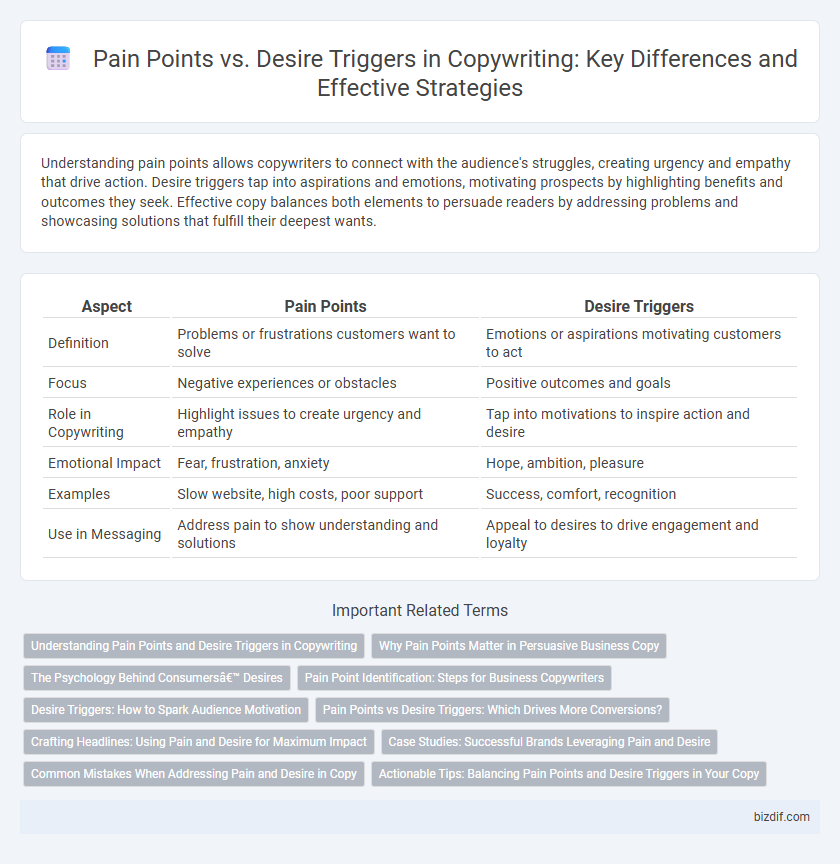Understanding pain points allows copywriters to connect with the audience's struggles, creating urgency and empathy that drive action. Desire triggers tap into aspirations and emotions, motivating prospects by highlighting benefits and outcomes they seek. Effective copy balances both elements to persuade readers by addressing problems and showcasing solutions that fulfill their deepest wants.
Table of Comparison
| Aspect | Pain Points | Desire Triggers |
|---|---|---|
| Definition | Problems or frustrations customers want to solve | Emotions or aspirations motivating customers to act |
| Focus | Negative experiences or obstacles | Positive outcomes and goals |
| Role in Copywriting | Highlight issues to create urgency and empathy | Tap into motivations to inspire action and desire |
| Emotional Impact | Fear, frustration, anxiety | Hope, ambition, pleasure |
| Examples | Slow website, high costs, poor support | Success, comfort, recognition |
| Use in Messaging | Address pain to show understanding and solutions | Appeal to desires to drive engagement and loyalty |
Understanding Pain Points and Desire Triggers in Copywriting
Understanding pain points in copywriting involves identifying the specific problems or challenges that the target audience faces, such as frustration with a product's usability or dissatisfaction with customer service. Desire triggers tap into the audience's aspirations and emotional motivators, highlighting benefits like improved lifestyle, status enhancement, or personal achievement. Effective copy balances these elements by addressing pain points clearly while inspiring desire through compelling, outcome-focused messaging.
Why Pain Points Matter in Persuasive Business Copy
Pain points in persuasive business copy highlight specific problems customers face, making the message relatable and urgent. Addressing these issues directly creates an emotional connection, driving motivation for action. Emphasizing pain points increases conversion rates by demonstrating empathy and offering targeted solutions that meet customer needs.
The Psychology Behind Consumers’ Desires
Understanding the psychology behind consumers' desires reveals that pain points highlight problems that trigger emotional discomfort, driving urgent need for solutions. Desire triggers, on the other hand, appeal to aspirations and positive emotions, motivating consumers by promising benefits, status, or fulfillment. Effective copywriting leverages this dynamic by addressing pain points to create relevance while activating desire triggers to inspire action.
Pain Point Identification: Steps for Business Copywriters
Effective pain point identification for business copywriters involves thorough audience research, including surveys and customer feedback analysis, to uncover genuine challenges faced by target customers. Mapping customer journeys allows writers to pinpoint moments of frustration or difficulty, enabling the creation of empathetic and solution-driven copy. Utilizing data analytics and competitor analysis further refines pain point accuracy, resulting in more persuasive and relevant messaging that resonates with potential buyers.
Desire Triggers: How to Spark Audience Motivation
Desire triggers tap into the audience's core aspirations, evoking emotions that fuel action and engagement. Crafting copy that highlights benefits, vivid imagery, and transformative outcomes can ignite motivation more effectively than focusing solely on pain points. Leveraging positive emotions and future success scenarios enhances connection and drives behavior toward conversion.
Pain Points vs Desire Triggers: Which Drives More Conversions?
Pain points highlight customer problems and frustrations, creating urgency that drives immediate action, while desire triggers tap into aspirations and positive emotions that foster long-term engagement and brand loyalty. Studies show that addressing pain points can boost conversion rates by up to 45% as customers seek solutions to their challenges. However, combining desire triggers with pain relief messaging often yields the highest conversion performance by balancing emotional appeal and problem-solving.
Crafting Headlines: Using Pain and Desire for Maximum Impact
Crafting headlines that tap into pain points captures the audience's attention by addressing their immediate problems, while invoking desire triggers inspires aspiration and emotional connection. Effective copy balances these elements, using language that highlights a solution to frustration alongside the promise of a rewarding outcome. Leveraging psychological triggers in headlines boosts engagement and drives higher conversion rates by resonating with both clients' needs and their aspirations.
Case Studies: Successful Brands Leveraging Pain and Desire
Successful brands like Nike and Apple harness pain points by addressing consumer frustrations, such as the need for comfort or intuitive technology, while simultaneously activating desire triggers through aspirational messaging and lifestyle appeal. Case studies reveal that Nike's campaigns focus on overcoming physical and mental barriers, motivating consumers with stories of perseverance, whereas Apple emphasizes sleek design and innovation to evoke desire for status and creativity. This balance between pain point relief and desire stimulation effectively drives consumer engagement and brand loyalty.
Common Mistakes When Addressing Pain and Desire in Copy
Many copywriters mistake overly focusing on pain points, causing potential customers to feel overwhelmed or defensive, rather than motivated to act. Ignoring desire triggers leads to bland messages that fail to connect emotionally, reducing engagement and conversion rates. Effective copy balances highlighting pain with vividly presenting the aspirational outcomes that resonate deeply with the target audience.
Actionable Tips: Balancing Pain Points and Desire Triggers in Your Copy
Effective copywriting balances addressing pain points and amplifying desire triggers by clearly identifying customer struggles while showcasing aspirational benefits. Use targeted language that empathizes with the audience's challenges and simultaneously presents compelling solutions that fulfill their deepest wants. Incorporate emotional storytelling and vivid imagery to create urgency and motivate immediate action.
Pain Points vs Desire Triggers Infographic

 bizdif.com
bizdif.com